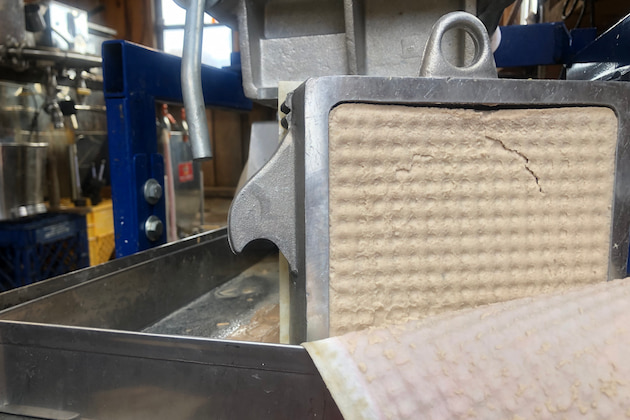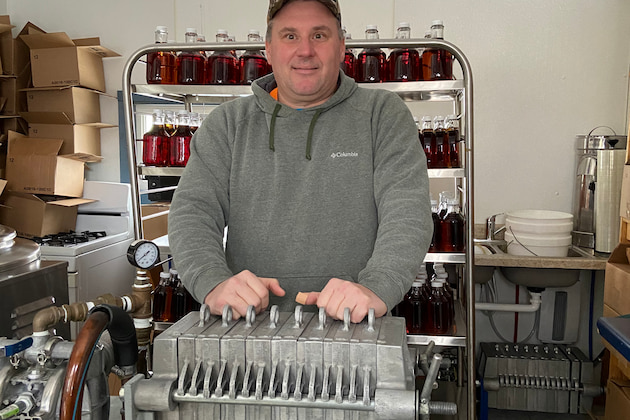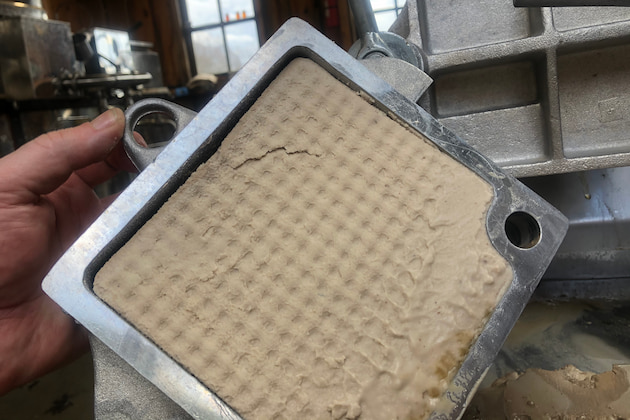Sap & Syrup
Keep an eye on the cake! Filtering tips from the experts
Too much or too little DE can be perplexing
By PETER A GREGG | MARCH 26, 2021
ANTIGO, Wisc.—Keep an eye on the cake.
That was the message from filtering expert Jim Adamski of Adamski’s Sugar Bush of Antigo, Wisc. during a webinar on filtering techniques hosted by the Wisconsin Maple Syrup Producers Association in January.
“If you are using too much DE the cake will be solid as a rock,” Adamski said. “You will barely be able to push it out of the plate. If it’s hard like a stone and crumbles and breaks apart, you can tell you are using too much DE powder.”
Diatomaceous earth is the common filter aid sugarmakers use to help pass the syrup through the filter sheets and take out the gunk and sand.
Too little or too much can be perplexing for the sugarmaker.
The best way to tell if you got it right is when you break down the press, a nice beige colored cake is formed between the plates.
“If we’re not seeing a nice solid cake then we didn’t use enough DE powder in the process,” Adamski said.
Early season syrup filters easily. The syrup will not filter as easily as the season progresses, so use more DE, he said.
When the end of the season comes and the syrup can barely filter at all, that’s when it’s time to shut down for the season.
“If you are getting stringy or ropy syrup, your sap has spoiled,” Adamski said. “I don’t care what kind of filter, when you get to that point there is no way to filter that ropy or stringyness out. You need to stop boiling.”
Filtering is one of the most important processes in syrup making, Adamski said.
“Syrup color can be affected by not filtering,” he said.
Old school ways of getting nitre out of syrup like using egg whites to coagulate the sand are not accepted practices anymore due to consumer food allergies.
Most effective is the filter press, where dirty syrup enters through the right and exits clean and clear on the left after passing through a paper filter with the help of the DE.
Less effective but also less expensive is using gravity, dumping syrup through a filter bag.
Bags should not be washed with perfumed detergents, he said. Only with pure hot water.
“Otherwise you will taste the soap in the syrup,” he said.
A clever new device for filtering are vacuum filters, offered by CDL. The sugarmaker can hook up a ShopVac to the filter and it sucks the syrup through the filter bags.
“Just make sure you have a dedicated ShopVac used only for the filter,” he said.
Adamski was joined in the seminar by sugarmaker Tim Sternitzky of Granton, Wisc. otherwise known as The Maple Dude.
“The filter press is the most influential purchase I made in my operation,” Sternitzky said. “It will give you crystal clear maple syrup straight through.”
Sternitzky advised sugarmakers to monitor their pressure gauges on the filter press.
“If the pressure drops that means you broke a paper,” he said.
Sugarmakers also want to be sure to keep the tiny holes in the plates free of clogs. It is the tiny holes in the the waffles of the plates that pass the syrup through.
“Keep the little holes in the waffle plates nice and clean and open,” Adamski said.
Pete Roth of Roth’s Sugar Bush in Cadott, Wisc. also was also asked for his tips on filtering.
Since Roth is also one of the state’s biggest bulk syrup buyers, he stressed that filtering end-of-season stringy syrup is not worth the extra effort.
“Stringy syrup should only be sold for bear bait,” Roth said. “It shouldn’t be filtered.”
Roth also advised to pay attention to the DE and make sure it is food grade only.
“You can go to the farm store and buy cheaper DE but it may not been made for our industry,” he said.
Particularly make sure the DE isn’t meant for swimming pools.
Roth also advised to keep ears open as much as eyes, listening close to the sound of the gear pump or air diaphragm pushing the syrup through the press.
If the speed changes, something probably happened inside and the syrup should be checked for cloudiness.
“The sound will tell you more than anything,” he said.


































